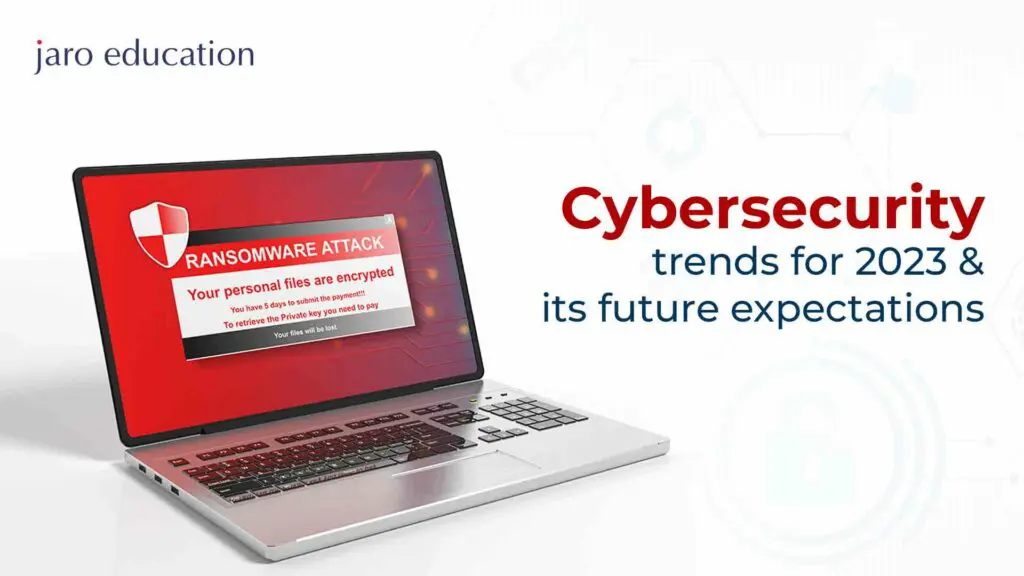Now more than ever, cybersecurity continues to be a critical area of concern for businesses and individuals. With the increasing number of cyberattacks from criminals and cyberfrauds, it is important to stay updated on the latest cybersecurity trends and future expectations to keep your digital assets secure. Investing in cybersecurity has become crucial for businesses to safeguard their intellectual property and finance. In this blog post, we will discuss the cybersecurity trends and what we can expect in the future.
Trends in Cyber Security:
Trend #1: Artificial Intelligence (AI) and Machine Learning (ML)
One of the major cybersecurity trends for 2023 is the use of AI and ML to enhance cybersecurity measures. These technologies have the potential to help organisations detect and prevent cyberattacks in real-time by analysing large amounts of data and identifying anomalies. AI and ML can also automate certain cybersecurity tasks, such as patching and updating software, reducing the workload of cybersecurity professionals.
However, the use of AI and ML also poses some challenges. Hackers may use these technologies to create more sophisticated attacks, and the algorithms used in AI and ML may have biases that could lead to false positives or false negatives. It is important for cybersecurity professionals to carefully monitor and regulate the use of these technologies to ensure they are being used ethically and effectively.
Trend #2: Cloud Security
With more businesses adopting cloud computing, cloud security has become an important concern for cybersecurity professionals. In the digital age , we can expect to see an increased focus on securing cloud environments and improving the security of cloud-based applications. This may include implementing stronger authentication mechanisms, encrypting data in transit and at rest, and using cloud-native security tools and services.
However, as with any technology, there are always risks associated with cloud computing. It is important for organisations to carefully evaluate the security of their cloud providers and implement appropriate security measures to protect their data.
Trend #3: Internet of Things (IoT) Security
The Internet of Things (IoT) refers to the network of physical devices, vehicles, home appliances, and other objects that are embedded with sensors, software, and connectivity to allow them to connect and exchange data. While the IoT has revolutionised the way we live and work, it has also created new security challenges. In the current times, working professionals can expect to see an increased focus on securing IoT devices and networks.
This may include implementing stronger authentication mechanisms, encrypting data in transit and at rest, and using IoT-specific security tools and services. However, the sheer number of IoT devices and the diversity of their operating systems and protocols can make it difficult to ensure their security. It is important for organisations to carefully evaluate the security of their IoT devices and networks and implement appropriate security measures to protect their data.
Trend #4: Zero Trust Architecture
Zero-trust architecture is a security model that assumes that every user, device, and application is a potential threat and should not be trusted by default. Instead, access to resources is granted on a need-to-know basis, and every access attempt is verified and authenticated. I professionals can expect to see increased adoption of zero-trust architecture as a way to enhance cybersecurity and reduce the risk of cyberattacks.
Zero-trust architecture can help organisations detect and prevent insider threats, mitigate the risk of data breaches, and improve the security of remote workers. However, implementing a zero-trust architecture requires a significant investment in technology and infrastructure, and it may require changes to existing business processes and workflows.
Future Expectations for Cybersecurity Trends
Looking beyond 2023, we can expect to see continued innovation in cybersecurity technologies and practices. As more devices and systems become connected to the internet, cybersecurity will become an increasingly complex and challenging field.
The Use of Quantum Computing to Enhance Cybersecurity
Quantum computing has the potential to break many of the encryption algorithms used to protect data today, but it can also be used to create new, unbreakable encryption techniques. As quantum computing continues to evolve, we can expect to see new cybersecurity applications that leverage this technology to protect against cyberattacks.
The Use of Blockchain Technology for Cybersecurity
Blockchain is a decentralised, immutable ledger that can be used to store data and transactions in a secure and transparent manner. In cybersecurity, blockchain can be used to create a tamper-proof record of security events and to authenticate users and devices.
The rise of the Internet of Behaviours (IoB) will bring new security challenges
IoB refers to the use of data from connected devices to influence human behaviour, such as by tracking consumer buying patterns or monitoring employee productivity. As IoB continues to evolve, it will become increasingly important to secure the data being collected and analysed.
Become an Expert in Cybersecurity with Post Graduation Certification in Cyber Security by IIT Palakkad
The Post Graduation Certification in Cyber Security from IIT Palakkad is the perfect cyber security course for those looking to stay ahead of cybersecurity threats and learn all about the latest developments. With a curriculum that covers topics such as Network Security in Ethical Hacking, Malware Analysis, and Foundations in Cyber Security and Applied Cryptography, etc, you’ll gain the knowledge and skills needed to protect digital assets from cyber threats.
This cyber security course also explores topics like cybercrime, cryptography and cryptanalysis, information security, and static and dynamic analysis, among others. With experienced faculty and a rigorous curriculum, this program offers a comprehensive and practical education in cybersecurity. Consult with our admission experts at Jaro Education. Enroll now to stay ahead of the curve and protect your digital assets with this course.
Conclusion
In 2023 and beyond, cybersecurity will continue to be a critical concern for individuals and organisations. To stay protected against cyber threats, it is important to stay updated on the latest cybersecurity trends and technologies in cybersecurity. The use of AI and ML, cloud security, IoT security, and zero-trust architecture are all important cybersecurity trends to watch ahead. Looking beyond, professionals can expect to see continued innovation in cybersecurity technologies and practices to keep pace with the evolving cyber threat landscape. By staying informed and implementing appropriate security measures, working professionals can help keep our digital assets secure.






